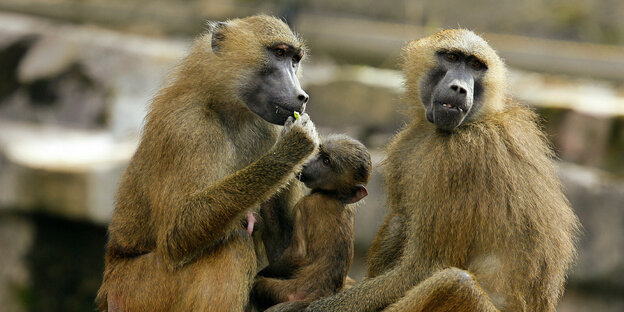Are people allowed to kill animals found in zoos? The issue is serious in Nuremberg: Guinea baboons thrive there too well.

Honestly, we humans don't know what is important or indifferent to these baboons at the Nuremberg Zoo. Photo: Daniel Karmann/dpa
“Baboons in danger: Nuremberg zoo wants to kill animals,” ProSieben headlined over the weekend. The headline inadvertently brings the dilemma to the point. Because Guinea baboons, which come from a relatively small area in West Africa, are truly in danger. Their habitat is shrinking and populations have been declining for decades. No improvement is in sight, on the contrary: one of its most important refuges, the Niokolo-Koba National Park in Senegal, is inscribed on UNESCO's List of World Heritage in Danger due to the continuous deterioration of its protection status.
Precisely because of this dangerous situation, the zoo now wants to kill some of its population and at the end of last week submitted a corresponding communication to the environmental committee of the city of Nuremberg for consultation on February 21. On the one hand, given the precarious situation of animals in their homeland, it is urgent to maintain a healthy reserve population in zoos.
This is the only way to relocate them to their original habitat later, when the problems are expected to be under control. They would not be the first: the bison, Przwalski's horse, the black-footed polecat and others have shown the way. All of these animal species would have become extinct long ago if they had not been bred in zoos and, after appropriate measures, returned to their natural habitat.
For this option to one day also exist for Guinea baboons, it is necessary for the monkey gang to constantly provide offspring. Animals do it with great joy: mating and raising young is one of their basic basic needs. However, since there is no shortage of lions, leopards and birds of prey in the zoo, but rather they are found in other enclosures, and because in case of illness a concerned veterinarian comes to the place, the number of baboons continues to increase.
Killing only for “reasonable reasons”
Simple Population Biology: In nature, the reproduction rate is designed to compensate for all types of losses. In the zoo, on the other hand, the animals live warm and safe, grow up well protected and become very old. There are currently 45 baboons in Nuremberg, although the facility is only designed for 25. An unsustainable situation in the long term, even from an animal welfare perspective.
Contraception does not work as desired, other zoos do not have free capacity, reintroduction is currently impossible due to the lack of habitats suitable for the needs of the baboons. That's why the zoo now wants to kill some of its animals to preserve a demographically healthy and reproductive population. Some animal rights activists react “shocked” (T-Online) and, as expected, threaten criminal charges.
According to the Animal Protection Law, killing animals is only permitted for “reasonable reasons.” Social consensus considers it sensible to raise pigs and cows with state subsidies in rather questionable conditions and then transform them into cutlets, sausages and goulash.
However, when zoo animals end up in lion cages after a comparatively paradisiacal life, there is great outrage. It is enough to remember the case of the giraffe Marius in the Copenhagen Zoo, whose killing and subsequent use as food for predators caused a real shit storm internationally. After all, a giraffe is nothing more than a cow with an extravagant neck.
The inhibition threshold is higher in monkeys because they are more closely related to us and significantly more intelligent. However, the latter can also be said about pigs, which does not save funny animals with bristly snouts from the “sensitive” end like hoepeters.
Most brutal death on the savanna
So is high cholesterol fundamentally more morally valuable than preserving a species? With this initiative, the Nuremberg Zoo not only wants to solve the monkey problem, but also start a social debate. The objective is to fundamentally recognize the “biological indication” for species protection as a reasonable reason for killing in order to achieve legal certainty in the management of the population of species kept under human care. The need for this is undoubtedly increasing in view of the increasingly dramatic biodiversity crisis.
To save at least some of the species we are in danger of losing in the coming decades, the only realistic solution in many cases is breeding for conservation “ex situ”, that is, under human care, which inevitably involves killing animals. , which can then end up in the next enclosure, to the delight of the lions. In nature, the result would be the same anyway, except that we humans would have stayed out of it.
The affected baboon is probably quite indifferent to this, apart from the fact that the circumstances of its death in the zoo are probably much more pleasant than on the savanna. Especially since it can help ensure that there will still be Guinea baboons in the future. And that is what in the end we all want: both the baboons and the lions and us humans too.